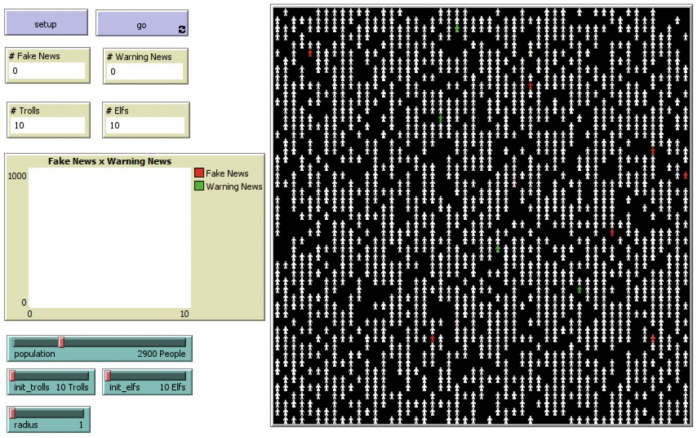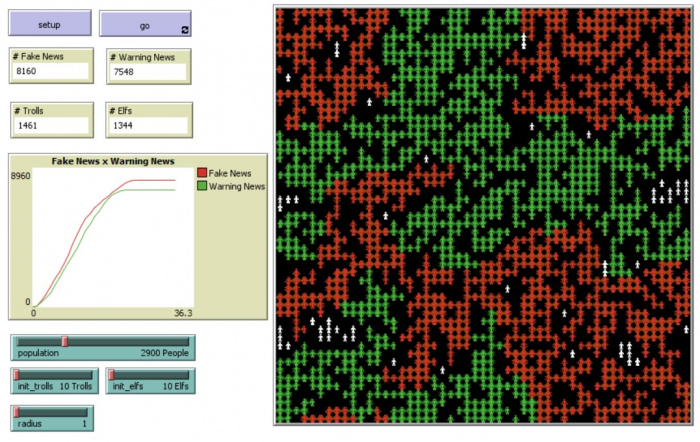Is it possible to stop fake news
NOT DONE YET, WORK IN PROGRESS
Name: Is it possible to stop fake news?
Author: Tomáš Martínek (mart13) (talk)
Method: MAS Simulation
Tool: NetLogo
Contents
Problem definition
Fake news is a global problem and it is getting worse every year. Is it possible to stop fake news? Fake news are made by people named "trolls". These trolls make fake news and send them to other people. On the other side of the table are elfs, who defend people from fake news and send "fake news warnings". When people receive fake news, they have basicaly three choices: resend it as it is (basicaly become troll), resend it with "fake news warning" (become elf) or dont resend it. Can elfs beat trolls and defend the majority of system from fake news?
The goal of this simulation is to find out what must happen to defend the majority of society from fake news.
Method
Simulation is creted in NetLogo software. I chose multi agent system aproach due to decentralization and autonomy of simulated environment.
Created MAS system consists of reactive agents. They only react to a few basic rules:
- If an agent has more fake news than warning news, agent becomes a troll and starts to send fake news to other people around.
- If an agent has more warning news than fake news, agent becomes an elf and starts to send warning news to other people around.
Model
As said before, the simulation is based on reactive MAS system. Let's briefly describe my implementation of the simulation and its user interface
Simulation
World
Fake news are mostly spread via e-mails and links via electronic messages in general. To simulate the environment of internet, I chose to create a square map without any borders on sides to simulate the unbounded space of internet. Everyone can reach anyone if they are somehow connected, in this simulation the connection is the distance of people.
Entities
Simulation model has technically only one entity, which is people. According to their properties I divide them into three groups:
- Trolls: was initiated as a troll or has more fake news than warnings at the moment.
- Elfs: was initiated as an elf or has more warnings than fake news at the moment.
- Basic people: people without any fake news or warning news.
Every group has a different colour and ability, trolls are red and can send fake news, elfs are green and can send warning news. Basic people are white.
It is a reflection of a real world situation, where there are only people too and according to their surrounding environment (family, friends, country they live, ...), they create their beliefs and opinions on the forthcoming news.
Relationships
The mechanism of sending fake and warning news is made of relationships between people. The simulation consists of two different relationship:
- Fake news relationship: a vizualization of sending a fake news from trolls
- Warning news relationship: a vizualization of sending a warning news from elfs
User interface
Overview
The simulation consists of inputs, monitors and a plot. Here is an overview and detail description.
User inputs
User can configure the setup rules for the simulation and change the behaviour of the model. Here is a list of configurable variables:
- Number of population
- Number of Trolls initiated at the beginning
- Number of Elfs initiated at the beginning
- Radius: a reachable distance for sending messages
Monitors and plots
To visualise the process of simulation, its variables and to show the results, the simulation uses some monitors and plots:
- Monitor: Number of Fake news sent
- Monitor: Number of Warning news sent
- Monitor: Number of Elfs
- Monitor: Number of Trolls
- Plot: Number of Fake news and Warning news in one graph
Scenario of simulation
The simulation begins with a population of people and a certain number of trolls and elfs. When the simulation starts running, trolls and elfs start to spread fake or warning news. As these news are spread, the basic population of people starts to emerge into elfs and trolls themselfs. The simulation can stop, when there is no changes in emergence of population and the numbers of trolls and elfs are stable.
Results
Very interesting variable of the model is Radius. Its value is a very important factor of a whole "life" of simulation. It defines the reachable space for agents to send messages to each other. I defined the limits of this variable from 1 to 5.
If the value is 1, only couple of surrounding agents are reachable by messages. Speed of the simulation is very slow and user can clearly see the spread of two different colours around the map. If the value is on its other extreme, 5, speed of the simulation is very intense and behaviour of the simulation is very chaotic for user.
Conclusion
The fake news simulation is a simplificated version of a real life problem but in my opinion very descriptive. It shows the fundaments of spreading fake news and their warnings in the society.
An extended version could have for example more sophistical layout of people. Some more dense groups of people could be created with inspiration from widely known leeks of e-mail adresses from any big web services (leeks I remember were for example from Facebook, Twitter, iCloud). In that situation the key connection factor, distance of people, would remain the same.
Sources
- https://www.nytimes.com/2021/11/22/world/europe/belarus-migrants-facebook-fake-news.html
- https://semantic-visions.com/resource/defending-the-covid-19-vaccination-pipeline
- https://www.cits.ucsb.edu/fake-news/spread
- https://thenextweb.com/news/ai-isnt-going-to-stop-fake-news-syndication
- https://www.bbc.co.uk/bitesize/articles/z6kxxyc
- https://ischool.syr.edu/fake-news-why-people-believe-how-it-spreads-and-what-you-can-do-about-it/
- https://futurism.com/fake-news-study-spread

